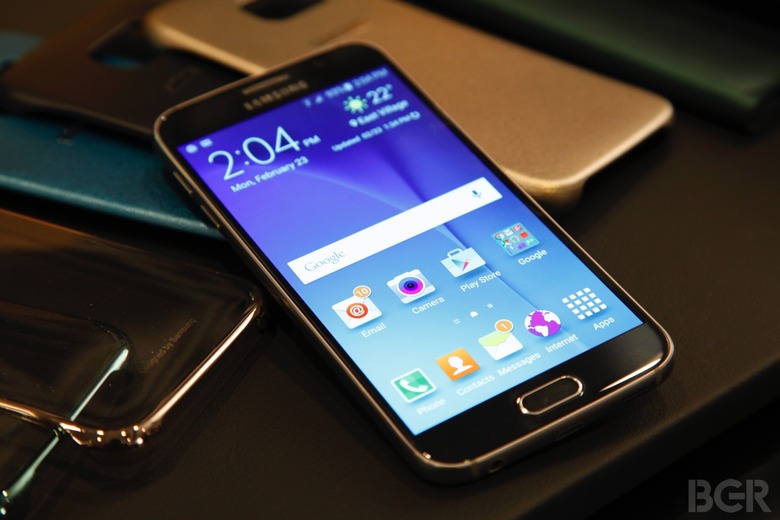Samsung Galaxy S6 Hands-On: Meet The Smartphone To Beat In 2015
What a difference a year can make. 2014's Galaxy S5 was, to put it plainly, an utter disappointment. It wasn't a bad phone by any stretch of the imagination, but it was hardly the exciting new Galaxy smartphone consumers were hoping for. Samsung's Galaxy S5 was the definition of an iterative update, and it was uninspired and boring compared to the gorgeous HTC One M8 and other flagship phones like the second-generation Moto X.
With the Galaxy S6, Samsung made up for everything that was wrong with the S5... and then some.
DON'T MISS: Samsung Galaxy S6 edge hands-on: We finally found the Galaxy we've been looking for
Leaks and rumors leading up to today's Galaxy S6 and Galaxy S6 edge unveiling made the S6 out to be a blatant iPhone copycat. While there are some things that bear an unmistakable resemblance to Apple's smartphone lineup, Samsung's new flagship is actually quite unique.
In meetings with Samsung last week, a top designer with the company's mobile division said that the Galaxy S6 was known internally as "Project Zero." Why zero? Because with the S6, Samsung says it started from scratch and its design team members were given the freedom to build the phone of their dreams.
The end result is fantastic.
Samsung's Galaxy S6 was designed from the ground up, and it is the first smartphone from Samsung to be made entirely of premium materials. The face and back are covered with Gorilla Glass 4, and the entire chassis including the sides and bottom are made of aluminum.
This phone feels amazing in the hand.
There are also some nice details that help set the Galaxy S6 even further apart from earlier Samsung phones, and from rival handsets as well.
On the back and front surrounding the screen, Samsung used a nifty reflective material that provides an interesting effect not seen on other devices. It's a bit intense in some colors — namely the blue on the S6 and the teal on the S6 edge — but it's a very nice touch for the most part.
Samsung did a terrific job on the phone's design. The Galaxy S6 is in an entirely new league for Samsung in terms of design, and it is easily one of the most beautiful smartphones that has ever been built. The phone is delightfully thin but doesn't compromise on performance or features at all; in fact, Samsung even managed to pack wireless charging support and "Samsung Pay" mobile payments support into the S6 and S6 edge.
Also of note, the camera on the Galaxy S6 is dramatically improved.
I was only able to spend about an hour with the phone during my meeting with Samsung, so I'll have to wait until I get my hands on a review unit before I can pass my final judgement. After some preliminary tests, however, it's easy to see that Samsung really stepped things up where image quality is concerned.
The rear camera on the Galaxy S6 is a 16-megapixel sensor with an F-Stop of f/1.9. With a simple double-tap on the home button even with the phone locked and asleep, the camera opens and is ready to snap a photo in just 0.7 seconds.
Samsung's new camera setup uses the infrared sensor in the heart rate monitor on the back of the phone to measure lighting and adjust the white balance as needed, and it also features smart optical image stabilization to reduce blur.
Finally, the camera features object tracking that lets you tap an object or person in your frame, and auto-focus will constantly adjust to keep it in focus as it moves.
Samsung's new TouchWiz software atop Android Lollipop also marks a significant new direction for the company.
In the past, Samsung seemingly tried to dump as many features as it possibly could into each new flagship phone. With the Galaxy S6, the company actually trimmed features... by a whopping 40%.
All of the bloatware we have come to loathe on Samsung phones has been removed. The user interface has also been toned down a great deal, and it lets Android shine through a bit more as a result. The early units I tested last week were fast and fluid thanks to their streamlined software, though the octa-core Exynos processor and 3GB of DDR4 RAM certainly help as well.
This is the first Samsung phone to include the company's latest Exynos chip, which is a 14-nanometer, 64-bit chipset that includes a quad-core 2.1GHz processor and a quad-core 1.5GHz processor.
I'll have plenty more to say about the Galaxy S6 in the coming days, and I am very much looking forward to reviewing this phone in the coming months.
Samsung has a long road ahead as it looks to return to growth after its profit has plummeted over the past couple of quarters. While the issue of pressure on the company's entry-level and mid-range handset business remains a serious one, Samsung's high-end phone sales are about to get a serious boost thanks to the Galaxy S6 and Galaxy S6 edge.
The Galaxy S6 will launch in April in the U.S., and it will be available from Verizon Wireless, AT&T, T-Mobile, Sprint and U.S. Cellular, as well as several smaller carriers and retailers such as Best Buy and Amazon.
Be sure to check out our Galaxy S6 edge hands-on for more details and for thoughts on the edge model, which is by far my favorite of the two.Complete Galaxy S6 specs can be seen here, and additional details can be found in this post.
